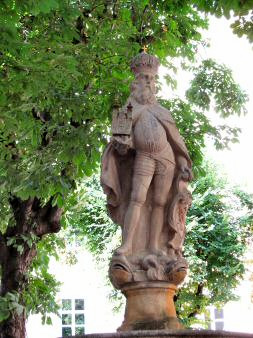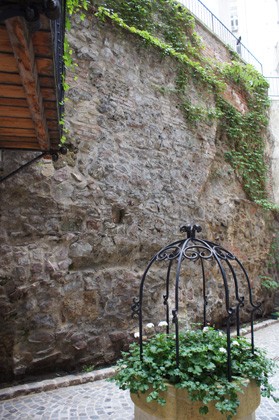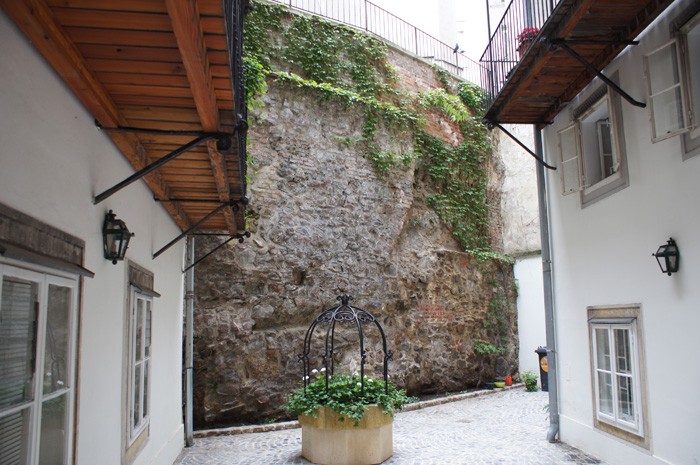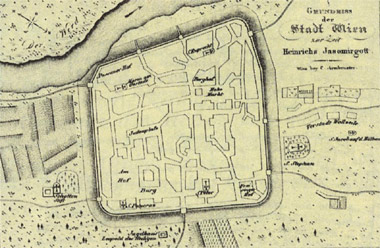History of Henry II Jasomirgott (* 1107; † 13 January 1177 in Vienna)
Henry II. Jasomirgott, monument at the town hall square in Vienna
At the time of Heinrich's birth, Austria was a county within the Duchy of Bavaria. Heinrich Jasomirgott's father is the Austrian Margrave Leopold III, his mother, Leopold's wife Agnes is the daughter of Emperor Heinrich IV (from the Salian family).
From 1140 to 1141 Henry II, as Count Palatine near the Rhine, administered the estates of his mother Agnes. The territory designated as the Electoral Palatinate corresponds to the present-day German states of Baden-Württemberg, Rhineland-Palatinate, Hesse, parts of Bavaria (Upper Palatinate), Saarland, the territory of what is now German-speaking Switzerland, and the Alsace region which today belongs to France. The centre was Heidelberg.
The successor of the Babenberg Margrave Leopold III as Margrave of Austria will first be another son of Leopold III, namely Leopold IV.
To understand the story, one has to go a little further. After the death of Emperor Heinrich V, the Saxon Lothar III of Supplinburg was elected
German king. In order to win the election he had promised his only daughter Gertrud to the son of the Duke of Bavaria from the family of the Guelphs. To our confusion this
son of the Guelphs and now son-in-law of Lothar was also called "Heinrich", later he was called 'Heinrich the Proud'. Lothar built up his son-in-law as successor for the
German royal crown and enfeoffed him with the duchies of Saxony and Bavaria and he became Margrave of Tuskien (Italy). After Lothar's death, Henry the Proud was too powerful
for the German princes. They elected Conrad III from the Staufer family as king.
Conrad III deprived Henry the Proud of his power. He banished him and stripped him of all his fiefdoms. The Duchy of Saxony goes to Albrecht the Bear and Bavaria to the
Babenberg Leopold IV.
An ideal condition for a conflict, which in the Middle Ages is usually solved on the battlefield. Thus a series of battles are fought.
On the side of the Staufer: Konrad III and Leopold IV.
On the side of the Guelphs: In Saxony: Heinrich the Proud and after his sudden death (murder) his underage son Heinrich the Lion supported by his grandmother Richenza and his mother Gertrud.
In Bavaria: Welf III, a brother of Heinrich the Proud.
When Richenza and also Leopold IV died unexpectedly, the German King Konrad III had the unique opportunity to settle the dispute between the Guelphs and the Staufers about the succession of the rule over the duchies of Saxony and Bavaria.
In January 1142 a meeting between Conrad III and Gertrude of Supplinburg took place in Braunschweig. The following was agreed:
-
Gertrud's son, Henry the Lion, receives Saxony and renounces his hereditary title, the Duchy of Bavaria.
Since he was still a minor, his mother Gertrude actually renounced for him. -
Heinrich II, Jasomirgott is enfeoffed with the Duchy of Bavaria.
-
Heinrich Jasomirgott renounces the goods of the Palatine Count near the Rhine. Thus a close relative of King Konrad was enfeoffed.
-
Gertrud tries to save from the Duchy of Bavaria what can still be saved and marries Heinrich Jasomirgott, whom she probably did not know at all or hardly knew.
King Konrad mediates the marriage as part of the peace package. Thus Gertrud became Duchess of Bavaria and Heinrich Jasomirgott unexpectedly comes to his first wife. When he heard about the planned marriage, he is said to have said that he was pleased that it would not only bring him the Duchy of Bavaria, but would also be very beautiful. The wedding was celebrated extensively.

Fountain of Jasomirgott in the courtyard of the Schottenstift
With this solution all conflicts should be eliminated and the family ties should prevent future disputes.
This peace lasted exactly one year, because then Gertrud died as a result of a difficult birth. Her son, the now grown-up Heinrich the Lion demanded the Duchy of Bavaria back. Heinrich Jasomirgott refuses.
The disputes are interrupted by a crusade. Heinrich Jasomirgott meets Princess Theodora from the Byzantine imperial house of the Comnenes in Byzantium and marries her.
The new emperor Frederick I. Barbarossa tried to find a balance with the Guelphs and in 1156 enfeoffed Henry the Lion with Bavaria (in addition to Saxony). Now a substitute had to be found for the Babenberg: This compensation was the Privilegium minus, by which Austria became an independent, self-governing duchy, independent of Bavaria.
Heinrich Jasomirgott moved the seat of the Babenbergs from Klosterneuburg to Vienna.
The empire of the Babenbergs (Bavaria and Swabia) shrank enormously to the territory of Lower Austria. But the new independent duchy of Austria with its new capital Vienna was born.
In 1156, Vienna became the residence of the new duchy and through the presence of the court also the cultural centre of the country. After the settlement covered barely two thirds of the Roman camp in the 11th century, it expanded so rapidly that Duke Heinrich II had to build his new residence on the city's western wall. The estate, which probably already existed, was given a palace and economic, administrative and residential buildings as well as storage buildings, all arranged around a courtyard. "At court" soon developed a glamorous courtly life. Henry II and his second wife Theodora entertained Emperor Frederick I Barbarossa here for two weeks.
Buildings that can be traced back to Heinrich Jasomirgott: the second Romanesque extension of St. Stephen's Church, the Scottish monastery in Vienna and the new construction of the Heiligenkreuz monastery founded by his father Leopold III. He replaced the wooden buildings with stone ones.

We owe him our present "Vienna". He created the conditions for Vienna to become a world city. He repaired the original Roman city walls. A tiny remainder of it is left in the courtyard of the house Maria at Gestade No. 5 (picture left, or above at the IPhone). The courtyard is not open to the public.
Larger picture of the courtyard of the Old Viennese House.


The Vienna of Henry II, Jasomirgott (mid-12th century)
Henry II Jasomirgott:
-
Count Palatine near Rhine 1140-1141
-
Margrave of Austria 1141-1156
-
Duke of Bavaria 1143-1156
-
Duke of Austria 1156-1177
Last resting place of Henry Jasomirgott and his second wife Theodora in the crypt of the Schottenkirche in Vienna
Descendants
From his first marriage to Gertrude:
-
Richardis (Richenza)
⚭ Heinrich Landgrave of Steffling
From his second marriage to Theodora:
-
Agnes of Austria, (* 1154, † 1185)
⚭ 1.) 1168 Stephen III King of Hungary (1161-1172), from the House of Árpád.
⚭ 2.) Hermann II. of Spanheim Duke of Carinthia, († 1181) -
Leopold V. Duke of Austria (1177-1194), Duke of Styria (1192-1194)
⚭ 1172 Ilona /Helene Princess of Hungary, († 25 May 1199), T. of King Géza II of Hungary -
Heinrich of Austria, Duke of Mödling (* 1156, † 11. September 1223), Bailiff of the monastery St. Emmeram in Regensburg,
⚭ 1179 Richza Princess of Bohemia, († 19 April 1182), T. v. King Vladislav II of Bohemia
